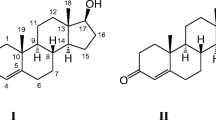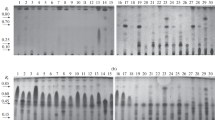Abstract
Forty-four strains of Aspergillus, Penicillium, Fusarium, Trichoderma and Rhizopus were grown on a liquid medium containing glucose and cassava-root extract. All of the Aspergillus and Fusarium strains, eight out of 10 Penicillium strains and three of seven Trichoderma strains showed linamarase activity. No such activity was detected in any Rhizopus strain. The crude enzyme preparation from F. oxysporum had the highest affinity for linamarin whereas that from A. nidulans was the most heat-stable.
Similar content being viewed by others
References
BrimerL., CicaliniA.R., FedericiF. & PetruccioliM. 1994 Production of β-glycosidases (linamarase and amygdalase) and pectolytic enzymes by Penicillium spp. World Journal of Microbiology and Biotechnology 10, 203–206.
CookeR.D. & CourseyD.G. 1981 Cassava: a major cyanidecontaining food crop. In Cyanide in Biology, eds VenneslandB., ConnE.E., Knowlesc.J., WestleyJ. & WissingF. pp. 93–114. London: Academic Press.
CourseyD.G. 1984 Potential utilization of major root crops with special emphasis on human, animal and industrial uses. In Tropical Root Crops: Production and Uses in Africa, eds TerryE.R., DokuE.V., AreneO.B. & MahunguN.M. pp. 25–35. Ottawa: IDRC.
FloresM.F., KoizumiY., YanagidaF. & GarciaV.V. 1990 Screening, isolation and identification of microorganisms with linamase activity. Nippon Shokuhin Kogyo Gakkaishi 37, 230–234.
IkediobiC.O., IbrahimS. & OgbonnaA.I. 1987 Linamarase from Fusarium equiseti. Applied Microbiology and Biotechnology 25, 327–333.
IkediobiC.O., OgunduE.C. & UkohaA.I. 1985 Production of linamarase from Aspergillus sydowi and Fusarium equiseti. Process Biochemistry 24, 99–102.
IkediobiC.O. & OnyikeE. 1982 The use of linamarase in gari production. Process Biochemistry 17, 2–5.
LancasterP.A., IngramJ.S., LimM.Y. & CourseyD.G. 1982 Traditional cassava-based foods: survey of processing techniques. Economic Botany 36, 12–45.
NambisanB. & SundaresanS. 1984 Plant toxins: spectrophotometric determination of cyanoglucosides in cassava. Journal of the Association of Official Analytical Chemists 67, 641–643.
OkaforN. & EjioforM.A.N. 1985. The linamarase of Leuconostoc mesenteroides: production, isolation and some properties. Journal of the Science of Food and Agriculture 36, 669–678.
OkaforN. & EjioforM.A.N. 1986 The microbial breakdown of linamarin in fermenting pulp of cassava (Manihot esculenta Crantz). MIRCEN Journal 2, 327–338.
PontecorvoG., RoperJ.A., HemmonsL.M., McDonaldK.D. & BuftonA.W.J. 1953 The genetics of Aspergillus nidulans. Advanced Genetics 5, 141–238.
WilkinsonG.N. 1961. Statistical estimation in enzyme kinetics. Biochemical Journal 80, 324–332.
YeohH.-H. 1989 Kinetic properties of β-glucosidase from cassava. Phytochemistry 28, 721–724.
Additional information
The authors are with the Department of Botany, National University of Singapore. Kent Ridge. Singapore 0511
Rights and permissions
About this article
Cite this article
Yeoh, HH., Tan, T.K. & Loh, C.M. Sources of fungal linamarases. World Journal of Microbiology & Biotechnology 11, 678–680 (1995). https://doi.org/10.1007/BF00361015
Received:
Accepted:
Issue Date:
DOI: https://doi.org/10.1007/BF00361015




